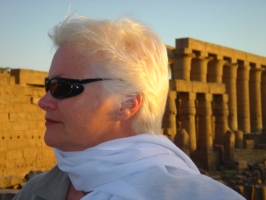Wednesday, December 27, 2006
Originally published in The Nome Nugget, Summer 1994
Alaska had a kind of a birthday last week: the 253rd anniversary of landfall by voyagers from the Old World. I had pictured Vitus Bering leaving his ship the St. Peter in a floppy little velvet cap like you see in portraits of Christopher Columbus, standing in the front of the shoreboat with a rippling Russian flag, and jumping onto the beach at Kayak Island on July 19, 1741, claiming it for Empress Catherine the Great. But there was nothing romantic about Bering’s last voyage to the American shore and that landing in Alaska.
(Continued)
Wednesday, December 27, 2006
Originally published in The Nome Nugget, Summer 1995
With special thanks to Leo Rasmussen for providing historical details.
It was in 1975 that Nome’s famous burled arch was first used as the finish marker for the Iditarod Sled Dog Race. Carl Huntington of Galena won the race in 1974 (in 20 days) but it was the last-place musher in that contest who was responsible for gracing Nome with it’s famous trail-end symbol. The Fox Lions Club north of Fairbanks donated the marker to the Bering Sea Lions Club in 1975 after Fox Lions Club member Red Fox Olson initiated the effort.
(Continued)
Wednesday, December 27, 2006
Originally published in The Nome Nugget, Summer 1994
A great culling process began the day we moved to Nome. The really great friends are being separated from the pretty good ones. And it’s all because we don’t live in Anchorage.
(Continued)
Wednesday, December 27, 2006
Originally published in The Nome Nugget, Summer 2004
Captain James Cook sailed the waters around Nome during the summer of 1778. He walked the deck of his ship Resolution that August and exchanged signals with Captain Furneaux on the consort ship Discovery as they measured the watery depths of Norton Sound, ever hopeful to find the way through North America to the Atlantic Ocean. And, after the morning watch, perhaps Cook retired to his cabin, looked over his maps, freshened up, and went to the galley to set a good example for his men with the sauerkraut.
(Continued)
Wednesday, December 27, 2006
Originally published in The Nome Nugget, Summer 1994
Nobody ever saved the town where I grew up. But I’d heard about Balto even when I went to school in California in the 1950s. The big, black husky (with a right front leg that looked like he’d stepped into a can of white paint) who saved Nome from an impending diphtheria epidemic is part of American mythology. And now I live in the town that he saved. But where is Balto? Nome doesn’t have a statue of Balto. We should. New York’s Central Park has a statue of Balto. Enter the park from the 67th Street and Fifth Avenue entrance and you can see children sitting on his back and rubbing his ears. The bronze shines brilliantly from all that attention. Sculptor Frederick G. Ross modeled Balto still in harness, panting, as if he’d just arrived at Dr. Welch’s house on that fateful February morning.
(Continued)
Wednesday, December 27, 2006
Originally published in The Nome Nugget, Summer 1995
I was amazed when I first saw Hawai’i’s flag. Many of you may assume like I did that it was cut from bold-colored fabric with jungle hues of blue and green or volcanic oranges and reds. It’s not. Hawaii’s colors are red, white, and blue, and their flag looks British. The design is indeed modeled after the flag of the United Kingdom. Three crosses are overlaid representing Northern Ireland (the cross of St. Patrick), Scotland (the cross of St. Andrew), and Britain (the cross of St. George). The eight red, white, and blue stripes represent Hawai’i’s eight major islands.
(Continued)
Wednesday, December 27, 2006
This was my first article published in The Nome Nugget, Summer 1994.
I’m trying to figure things out in Nome. So, before I arrived, I watched a special on television on the Iditarod to help me figure things out. I noticed that everybody at the Nome finish line had on lots of clothes: boots as big as tree trunks, parkas with huge fur ruffs that obscured their faces, gloves and mittens that dwarfed their arms. I turned to my children and announced glumly, “It’s going to be cold.”
(Continued)
Tuesday, December 26, 2006
Originally published in Connections, 1999
Sometimes a year will stand out in your memory as a bad one. It may not have been difficult every single week, or perhaps even every month, but looking back over a particular twelve months can bring overwhelming feelings of sadness, conflict, or anger. You can’t wait to throw out that calendar.
(Continued)
Tuesday, December 26, 2006
Originally published in Connections, a La Leche League USWD administrators’ publication, in about 2000
When I was a new Leader in New Mexico, I wrote quite a few articles for their ALL Enchantment. The trouble was my essays and poems for that publication were personal and all about mothering: artwork with children, difficult mothering days, a miscarriage, and a breast infection.
(Continued)
Tuesday, December 26, 2006
Originally published in The South Bay Daily Reporter, California, Summer 1994
I don’t know if anybody ever saved Manhattan Beach. I kind of wish somebody could have saved it from the polio that swept through my family in 1954. But, if anybody did save the Beach Cities from a more severe epidemic, there hasn’t been a statue, plaque, race, or a book in commemoration. Not like in Nome.
(Continued)
